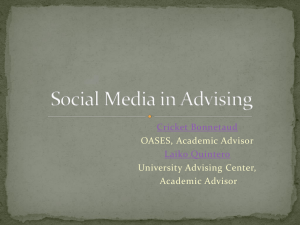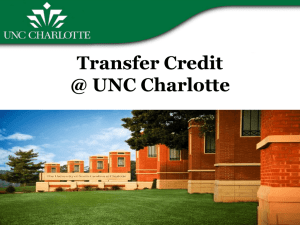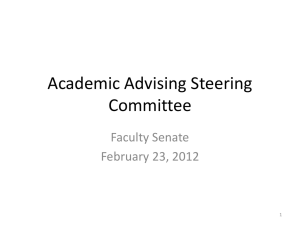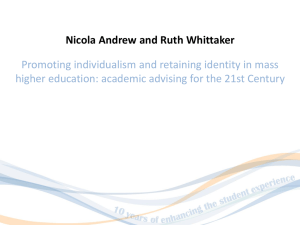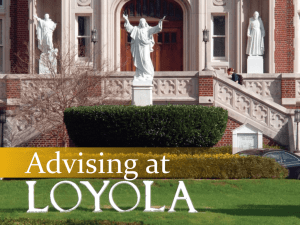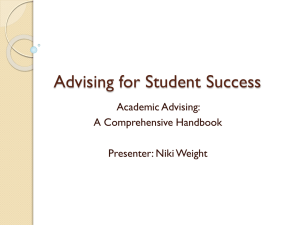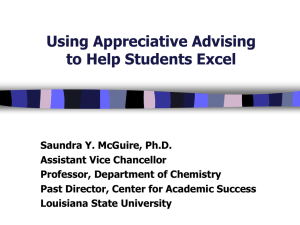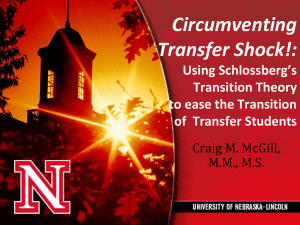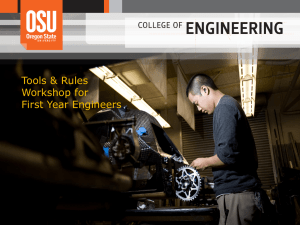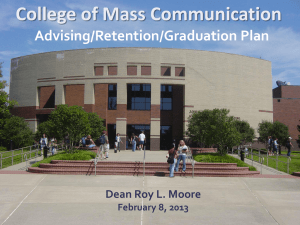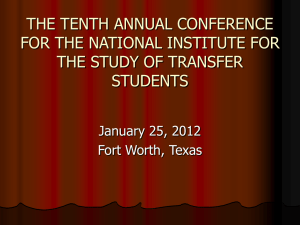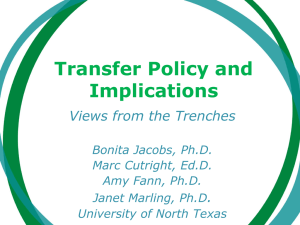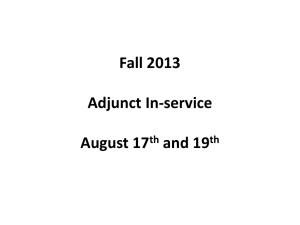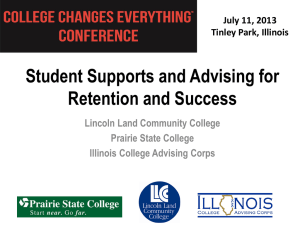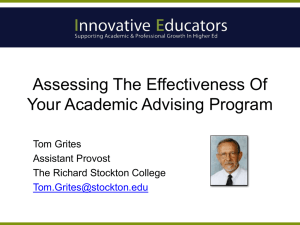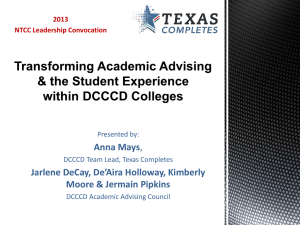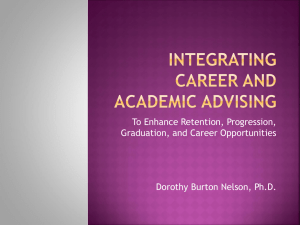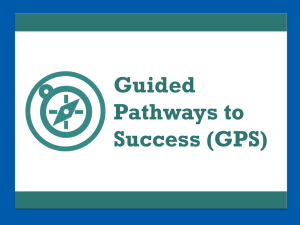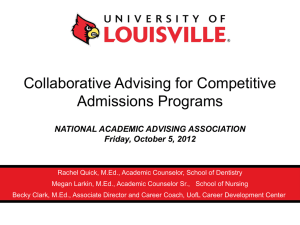Unique Needs of Transfer Students
advertisement
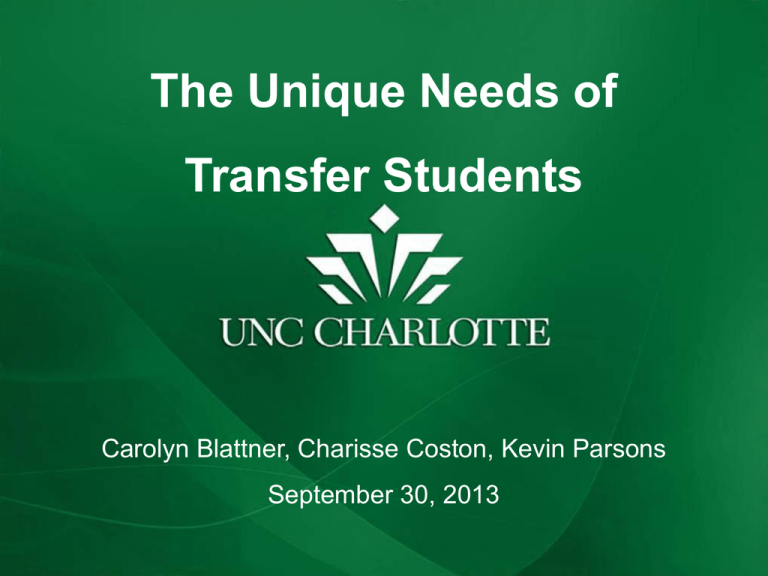
The Unique Needs of Transfer Students Carolyn Blattner, Charisse Coston, Kevin Parsons September 30, 2013 Goals • Consider characteristics of transfer students • Understand some of the challenges transfer students face • Discuss implications for academic advising to support transfer student success Snapshot of UNC Charlotte Transfers Entering Transfer Class, Fall Semester 3541 4000 2798 3000 2568 2203 2000 1906 1631 1000 0 2000-01 2006-07 2012-13 New Freshmen New Transfers Tamara Johnson, Student Success at UNC Charlotte: A Series of Working Papers New TR Student Demographics 2011-2012 Prior Institution •73% from NC institutions •51% from NC community colleges •CPCC largest single feeder Credit Hours Transferred ~30% transfer 61-75 hours ~38% transfer 31-60 hours ~21% transfer 30 or fewer hours Cynthia Wolf Johnson, Student Success Working Group (February 12, 2013) Claire Kirby, Student Success Working Group (April 9, 2013) UNC Charlotte Transfer Population by College Fall 2011 College COAA COB CCI COED COEN CHHS CLAS UCOL No College Designated TOTAL Number of Number of Enrolled Enrolled Transfers Undergrads Percentage 340 947 36% 1,404 2,913 48% 392 919 43% 517 1,183 44% 954 2,533 38% 952 2,250 42% 3,303 7,104 46% 733 2,325 32% 1 109 1% 8,596 20,283 42% Source: Report Central, All Undergraduate Student Demographics, retrieved July 2013 Summary – One Year Persistence Cohorts: FALL 2005-2007-2009-2011; Criteria #1: Transfer Origin; Criteria #2: Initial Enrollment Status Transfer Origin Community College graduates 2-Year school, no degree 4-year school, no degree Second degree and other Initial Enrollment Status 2011 (N=2407) Full-Time 84.9% Part-Time 68.6% Full-Time 78.3% Part-Time 68.0% Full-Time 77.6% Part-Time 64.1% Full-Time 64.9% Part-Time 63.4% Full-Time 79.3% (78.0 FR) Part-Time 66.9% TOTAL Cynthia Wolf Johnson, Student Success Working Group (February 12, 2013) EASE Survey The Successful Transfer Student •Most attempted hours and higher attempted /earned hours ratio •Previous education experience matters (hours earned & degree attainment) •Highest first semester GPA •Self report that they were most prepared for class •Self report that they know when to seek out faculty for help if needed Ted Elling, Student Success Working Group (April 23, 2013) National Context Transfer swirl: attending multiple institutions to earn degree Transfer shock: dip in transfer student’s grades during first semester at new institution Activity Two-minute Brainstorm: • Group 1: Academic issues for transfer students • Group 2: Social/Emotional issues for transfer students • Group 3: Financial issues for transfer students Transitions: Academics • Academic Performance: New Transfers are placed on academic probation at higher rates than New Freshmen at end of first fall semester • Class Size: Many new students report class sizes less than 50 at previous institution • Logistics of Transfer: New transfers regularly report questions about transfer credit, exemptions, requirements Source: Academic Standing of All Undergraduate Students Report, Fall 2011, Institutional Research Source: Informal Survey, SOAR 2013 Transfer Student Stories Many transfer students self-identify challenges and realize what they need to be successful. Transfer Student Challenges Academic “In the past while taking courses at CPCC, I felt less motivated while being there so I was just doing assignments to get by. I will be using all the resources that are available to me to go above and beyond.” Advising Implications: Academic Challenges Progression: • • Use CAPP and advising transcript Pay close attention to course attributes and course electives General Education: • • • General Education attribute exempts student from specific requirement Contact Admissions or suggest student make appeal if course title seems similar to GenEd requirement University Advising Center can assist Advising Implications: Academic Challenges Academic policy • Explain tuition surcharge or suggest student review policy if transferring large number of credits • GenEd appeals go to Dean of University College • Major/minor appeals go to dept. chair • GPA does not transfer • Ask about completion of associate’s degree if student has large number of community college credits • Beware of repeated courses when possible • Remind student that UNC Charlotte policies may be different than those at previous institution Advising Implications: Academic Challenges Academic Performance • Help student select courses that meet requirements and allow for successful performance • Discuss strategies for succeeding in large courses • Encourage connection with faculty • Encourage use of campus resources • Encourage regular class attendance Transfer Student Challenges Socio-Emotional “I hope to find time to join and participate in at least a few clubs/organizations while I’m here, as well as enjoy catching our school athletic teams compete. Also, I’m hoping to forge some long-lasting friendships that will endure even after graduation.” Advising Implications: Socio-Emotional Challenges Engagement—Academic and Social • • • • • Encourage student to connect with faculty and become involved in life of the department (honorary, research opportunities, events) Encourage regular contact and connection with advisor Discuss social and community engagement opportunities Encourage connection with University Career Center early Consider ways that internships or other experiential learning opportunities may fit into student’s plan Transfer Student Challenges Financial “Everyday expenses and renting is a headache, but I plan to use Financial Aid and National Guard benefits to help. Maybe a campus job too.” Advising Implications: Financial Challenges • • • • • • Discuss work/school balance Refer to Office of Student Financial Aid Refer to University Career Center, on-campus job postings Understand residency requirements (in-state and out-of-state) Explain possibility of tuition surcharge Student will want to consider family financial situation (dependence) A Faculty Advisor Summary •Concerns •Challenges for advisors •Challenges for students •Expectations Criminal Justice and Criminology Department • About half of our undergraduate population in major are transfer students • Transfer students were graduating at slower pace than native students CJUS Learning Community Goals • To aid academic and social transition during the transfer process • To provide a sense of belonging • To introduce students to the major and to UNC Charlotte • To involve students in the major and/or UNC Charlotte through a self-chosen volunteer experience Year Long Program • Limited to 25 newly admitted transfer students • Course 1: Graded, Writing-Intensive requirement • Blocked Seating in another course, dependent upon pre-major or major • Course 2: Graded, Oral Communication requirement, includes volunteer experience Descriptive Characteristics of Two Samples Non-Traditional (53) Frequency Percentage Race White Black Hispanic International Gender Male Female Traditional (47) Frequency Percentage 30 15 6 1 57 28 11 2 24 18 2 3 51 38 4 6 24 29 45 55 23 24 49 51 Descriptive Characteristics of Two Samples (cont.) Non-Traditional (53) Traditional (47) 25 (2.1) 21 (2) Non-Traditional (53) Frequency Percentage Traditional (47) Frequency Percentage Median Age and Standard Deviation Status Pre-Majors 32 60 41 87 21 40 6 13 *must take Intro to CJ and Stats before matriculating to major) Majors Research on Transfer Student Stressors Method •LC students were asked to indicate their biggest stressors (open-ended), and then to rank order the intensity of stressor(s) •Question asked at three times during the year of participation in LC. Results: Top 5 Non-Traditional Student Stressors 1. 2. 3. 4. 5. Learning New Campus Transfer Credit Loneliness Balancing full time work and school New rules and practices Results: Top 5 Traditional Student Stressors 1. Learning New Campus 2. Transfer Credit 3. Registering for Classes (tie) Loneliness 4. Transferring from Pre-Major to Major 5. Learning new policies and rules Sources This presentation is based, in part, upon material derived from the following sources: Coston, C; Blowers, A, and D. Baals. (under editorial review) Non-traditional transfer students: Assessing academic outcomes from participants in a criminal justice learning community. Lord, V.; Coston C; Blowers, A; Davis, B. and K. Johannes (2012). The multidimensional impact of a transfer learning community. Journal of First Year Experience and Students in Transition. Vol.24 (2). Coston, C; Lord, V. and J. Monell (2010). Improving the success of transfer students: Responding to risk factors. Journal of Learning Community Research. 5 (2). Reprinted in Learning Communities Research and Practice . 1 (1). Campus Resources •Tau Sigma Transfer Student Honor Society •Office of Adult Students and Evening Services (OASES) •Transfer Student Admissions website •Office of the Registrar •Facebook group called “Transfer Students-UNC Charlotte” •University Career Center •University Center for Academic Excellence •Office of Student Activities •Veteran Student Outreach •Multicultural Academic Services •Advising and student services office listed for your major and college • Transfer Specialists in Dean of Students, University Advising Center, and University Career Center •Office of Financial Aid and Scholarships •General advising website (http://www.advising.uncc.edu/) Conclusions Advisors can continue to advocate for transfers and become informed about unique needs. CJUS provides one model that addresses Academic, Socio Emotional, Work/Financial issues Questions/Discussion

